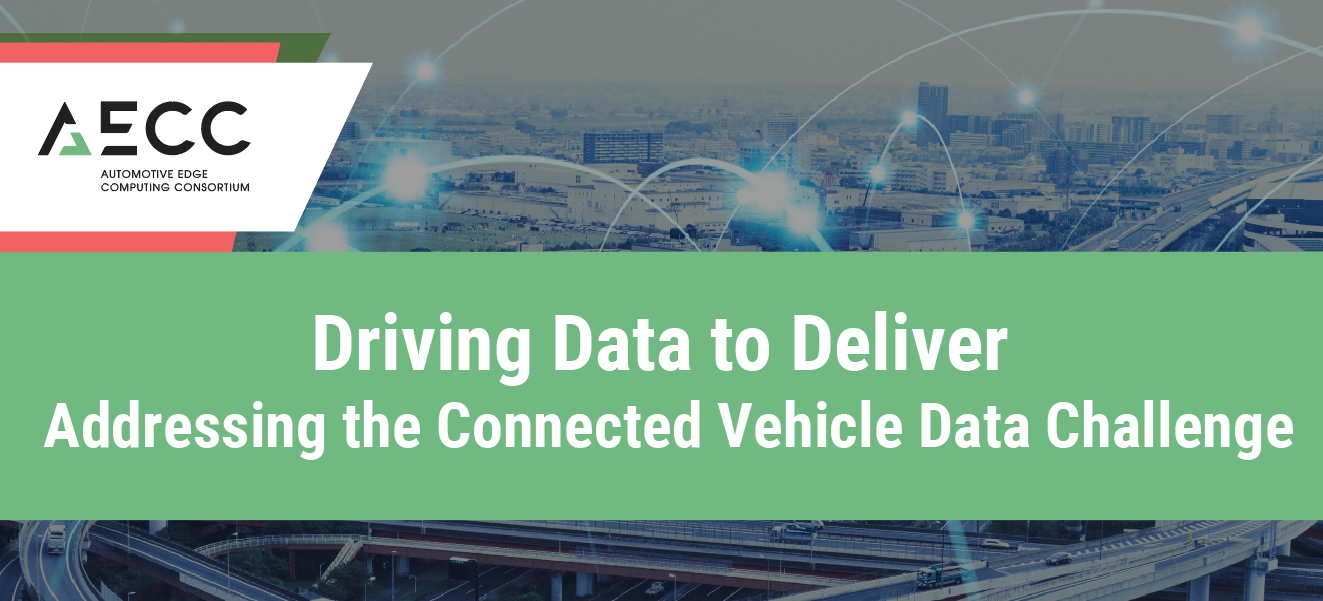Driving Data to Deliver: Addressing the Connected Vehicle Data Challenge


Blog written by: AECC President and Chairperson Ken-ichi Murata-san, AECC Directors Christer Boberg and Roger Berg
If you’re new to connected vehicles, one way to picture the market is a bucket of related use cases for the internet of things (IoT). As objects in the IoT, connected vehicles use on-board sensors to automate their operation and provide unique mobile services – for both the vehicle and the people inside. Each car, truck, drone or other mobile device depends on low-latency connectivity with compute resources that collect and enrich data, as well as the use of artificial intelligence (AI) to execute complex analytics and direct vehicle actions and services. In the process of optimizing this model, you quickly bump into what the AECC refers to as the data challenge for connected vehicles.
A cheap and easy framework for these requirements is to use what we’ve got: the existing cellular network connected to cloud data centers. This is how most connected vehicles operate today. But due to several technical issues, this legacy approach will not work for long and is heading for a major roadblock.
What’s Needed for a New Model
As mentioned, the infrastructure model for connected vehicles entails two sides: network and compute. Data moves back and forth from mobile vehicles, and compute action on the data determines what the connected vehicles and services should do. How do we make the system work effectively and as a good business model?
Predictions are for a globally soaring connected vehicle market, so we must think about this problem in terms of hundreds of millions of vehicles, and collectively the billions of “things” that will make it all work together. The scientists at AECC member companies treat this problem systematically as one of networking and computational scalability. As with any big data use case, it entails volume, variety and velocity of the data flowing within the model.
A new infrastructure model for connected vehicles will need to support a likely scenario described in the AECC’s white paper introduction General Principle and Vision. By 2025, the forecast is:
- Connected vehicles will generate about US$150 billion in annual revenue.
- The global number of connected vehicles will grow to about 100 million.
- The data volume transmitted between vehicles and the cloud will be about 100 petabytes per month.

Clarifying Data Assumptions for the Model
The scale of numbers in the prediction above is so large that we should pause to clarify what they mean in the real world. Let’s consider a key area of interest: data volume.
How much data is 100 petabytes? The arithmetic response is either 100,000 terabytes, 100,000,000 gigabytes, or 100,000,000,000 megabytes. To most people, these numbers are meaningless, but everyone can relate to descriptive analogs; 1,585 years of 4K video streamed 24×7; 33 billion songs stored as three megabyte MP3s (Spotify’s catalog has 50 million songs); or a monthly invoice for storage from Amazon Web Services for US$2.1 million.
Multiply any of those by 12 and you get the annualized version of our conservative forecast.
The scenario’s forecasted data volume assumes each vehicle will transmit just one gigabyte per month. Our conservative assumption is by 2025, the only valid services will be those that can be accommodated by currently planned network capabilities and business models.
Future automotive services, in fact, will transfer much larger data volumes. Some of the expected services will include intelligent driving, high-definition map generation, V2Cloud cruising assist, and others. The AECC estimates that aggregated data traffic for services like these will reach from one up to 10 exabytes per month by 2025 – at least one thousand times more than the present volume.
Ten exabytes is equal to one billion gigabytes. How much is that? A lotta bytes, to be sure!
About the Network and Compute Infrastructure
The more realistic data volume estimate signals an urgent need for new network architectures and compute infrastructure to support massive analytical capabilities and storage capacity for balancing quality and cost. Achieving this requires new actions; failure to do so will limit the evolution of operational capabilities and future services for connected vehicles.
Evolving cellular network standards are one part of meeting massive data volume, variety and velocity requirements for connected vehicles. Examples are the 3rd Generation Partnership Project (3GPP) and its cellular vehicle-to-everything (C-V2X) communication protocol, or 5G’s massive machine type communication such as the 3GPP 5G-NR.
Inadequate connectivity isn’t the only infrastructure issue. The trend of concentrating data processing at central locations will amplify huge data transmission traffic, which will lead to unnecessarily long response times and increase overall computation time.
For example, assuming 20GB per month per vehicle and three million vehicles (12% market share and 25% regional ratio of 100 million vehicles), 60 petabytes of vehicle data will come to the cloud every month. Assuming the data transaction rate at the cloud is 10GB per second, it will take 70 days to complete a month of transactions. Obviously, this is too slow for the real-time requirements of connected vehicles.
Toward a New Vision for Connected Vehicles
Our work at the AECC is to design a new infrastructure model, and recommend standards and use cases that leverage existing mobile communication network architectures and cloud computing systems to be fully optimized for connected vehicle requirements. Our aim is to foster the adoption of this redesigned system architecture on a global scale. Achieving this will require collaboration by worldwide stakeholders and a system architecture that complies with relevant standards. That’s what membership in the AECC and participation in formulating this vision is all about.
If you’d like to learn more details about our work and preliminary recommendations for addressing the challenges described above, we invite you to read our General Principle and Vision white paper, and our recently-updated technical report, Driving Data to the Edge: The Challenge of Traffic Distribution. Meanwhile, keep your eye on this blog for new insights that we’ll share over the coming months.
